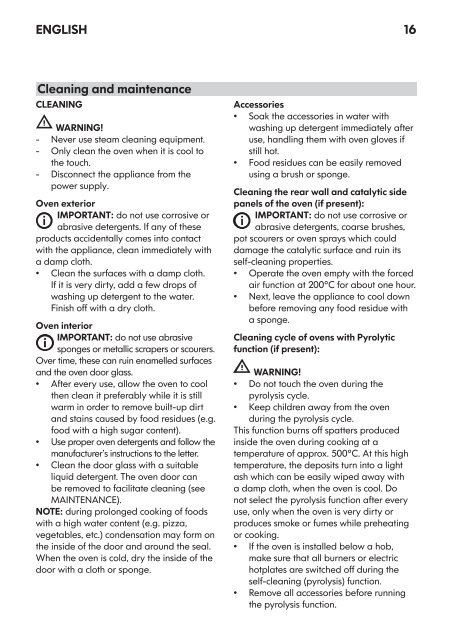KitchenAid OVN 908 W - OVN 908 W IT (857923201010) Istruzioni per l'Uso
KitchenAid OVN 908 W - OVN 908 W IT (857923201010) Istruzioni per l'Uso
KitchenAid OVN 908 W - OVN 908 W IT (857923201010) Istruzioni per l'Uso
You also want an ePaper? Increase the reach of your titles
YUMPU automatically turns print PDFs into web optimized ePapers that Google loves.
ENGLISH 16<br />
Cleaning and maintenance<br />
CLEANING<br />
--<br />
--<br />
--<br />
WARNING!<br />
Never use steam cleaning equipment.<br />
Only clean the oven when it is cool to<br />
the touch.<br />
Disconnect the appliance from the<br />
power supply.<br />
Oven exterior<br />
IMPORTANT: do not use corrosive or<br />
i<br />
abrasive detergents. If any of these<br />
products accidentally comes into contact<br />
with the appliance, clean immediately with<br />
a damp cloth.<br />
• Clean the surfaces with a damp cloth.<br />
If it is very dirty, add a few drops of<br />
washing up detergent to the water.<br />
Finish off with a dry cloth.<br />
Oven interior<br />
IMPORTANT: do not use abrasive<br />
i<br />
sponges or metallic scra<strong>per</strong>s or scourers.<br />
Over time, these can ruin enamelled surfaces<br />
and the oven door glass.<br />
• After every use, allow the oven to cool<br />
then clean it preferably while it is still<br />
warm in order to remove built-up dirt<br />
and stains caused by food residues (e.g.<br />
food with a high sugar content).<br />
• Use pro<strong>per</strong> oven detergents and follow the<br />
manufacturer’s instructions to the letter.<br />
• Clean the door glass with a suitable<br />
liquid detergent. The oven door can<br />
be removed to facilitate cleaning (see<br />
MAINTENANCE).<br />
NOTE: during prolonged cooking of foods<br />
with a high water content (e.g. pizza,<br />
vegetables, etc.) condensation may form on<br />
the inside of the door and around the seal.<br />
When the oven is cold, dry the inside of the<br />
door with a cloth or sponge.<br />
Accessories<br />
• Soak the accessories in water with<br />
washing up detergent immediately after<br />
use, handling them with oven gloves if<br />
still hot.<br />
• Food residues can be easily removed<br />
using a brush or sponge.<br />
Cleaning the rear wall and catalytic side<br />
panels of the oven (if present):<br />
IMPORTANT: do not use corrosive or<br />
i<br />
abrasive detergents, coarse brushes,<br />
pot scourers or oven sprays which could<br />
damage the catalytic surface and ruin its<br />
self-cleaning pro<strong>per</strong>ties.<br />
• O<strong>per</strong>ate the oven empty with the forced<br />
air function at 200°C for about one hour.<br />
• Next, leave the appliance to cool down<br />
before removing any food residue with<br />
a sponge.<br />
Cleaning cycle of ovens with Pyrolytic<br />
function (if present):<br />
WARNING!<br />
• Do not touch the oven during the<br />
pyrolysis cycle.<br />
• Keep children away from the oven<br />
during the pyrolysis cycle.<br />
This function burns off spatters produced<br />
inside the oven during cooking at a<br />
tem<strong>per</strong>ature of approx. 500°C. At this high<br />
tem<strong>per</strong>ature, the deposits turn into a light<br />
ash which can be easily wiped away with<br />
a damp cloth, when the oven is cool. Do<br />
not select the pyrolysis function after every<br />
use, only when the oven is very dirty or<br />
produces smoke or fumes while preheating<br />
or cooking.<br />
• If the oven is installed below a hob,<br />
make sure that all burners or electric<br />
hotplates are switched off during the<br />
self-cleaning (pyrolysis) function.<br />
• Remove all accessories before running<br />
the pyrolysis function.
















